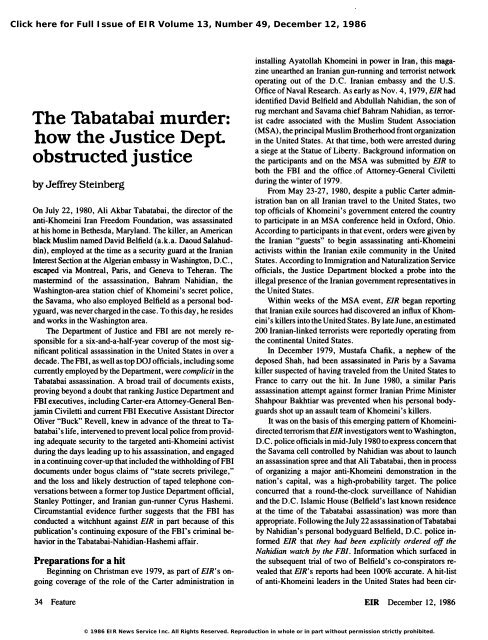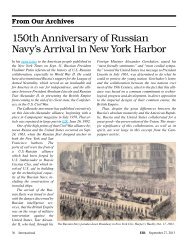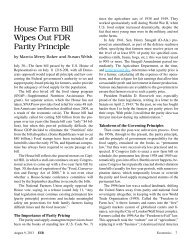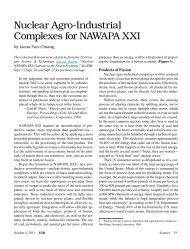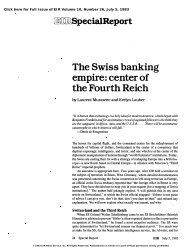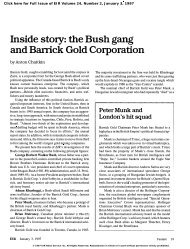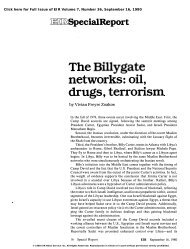The Tabatabai Murder - Executive Intelligence Review
The Tabatabai Murder - Executive Intelligence Review
The Tabatabai Murder - Executive Intelligence Review
You also want an ePaper? Increase the reach of your titles
YUMPU automatically turns print PDFs into web optimized ePapers that Google loves.
Click here for Full Issue of EIR Volume 13, Number 49, December 12, 1986<br />
<strong>The</strong> <strong>Tabatabai</strong> murder:<br />
how the Justice Dept<br />
obstructed justice<br />
by Jeffrey Steinberg<br />
On July 22, 1980, Ali Akbar <strong>Tabatabai</strong>, the director of the<br />
anti-Khomeini Iran Freedom Foundation, was assassinated<br />
at his home in Bethesda, Maryland. <strong>The</strong> killer, an American<br />
black Muslim named David Belfield (a.k.a. Daoud Salahud<br />
din), employed at the time as a security guard at the Iranian<br />
Interest Section at the Algerian embassy in Washington, D.C.,<br />
escaped via Montreal, Paris, and Geneva to Teheran. <strong>The</strong><br />
mastermind of the assassination, Bahram Nahidian, the<br />
Washington-area station chief of Khomeini's secret police,<br />
the Savama, who also employed Belfield as a personal bod<br />
yguard, was never charged in the case. To this day, he resides<br />
and works in the Washington area.<br />
<strong>The</strong> Department of Justice and FBI are not merely re<br />
sponsible for a six-and-a-half-year coverup of the most sig<br />
nificant political assassination in the United States in over a<br />
decade. <strong>The</strong> FBI, as well as top DOJ officials, including some<br />
currently employed by the Department, were complicit in the<br />
<strong>Tabatabai</strong> assassination. A broad trail of documents exists,<br />
proving beyond a doubt that ranking Justice Department and<br />
FBI executives, including Carter-era Attorney-General Ben<br />
jamin Civiletti and current FBI <strong>Executive</strong> Assistant Director<br />
Oliver "Buck" Revell, knew in advance of the threat to Ta<br />
batabai's life, intervened to prevent local police from provid<br />
ing adequate security to the targeted anti-Khomeini activist<br />
during the days leading up to his assassination, and engaged<br />
in a continuing cover-up that included the withholding of FBI<br />
documents under bogus claims of "state secrets privilege,"<br />
and the loss and likely destruction of taped telephone con<br />
versations between a former top Justice Department official,<br />
Stanley Pottinger, and Iranian gun-runner Cyrus Hashemi.<br />
Circumstantial evidence further suggests that the FBI has<br />
conducted a witchhunt against EIR in part because of this<br />
publication's continuing exposure of the FBI's criminal be<br />
havior in the <strong>Tabatabai</strong>-Nahidian-Hashemi affair.<br />
Preparations for a hit<br />
Beginning on Christman eve 1979, as part of EIR's on<br />
going coverage of the role of the Carter administration in<br />
34 Feature<br />
installing Ayatollah Khomeini in power in Iran, this ,maga<br />
zine unearthed an Iranian gun-running and terrorist network<br />
operating out of the D. C. Iranian embassy and the U. S.<br />
Office of Naval Research. As early as Nov. 4,1979, EIRhad<br />
identified David Belfield and Abdullah Nahidian, the son of<br />
rug merchant and Savama chief Bahram Nahidian, as terror<br />
ist cadre associated with the Muslim Student Association<br />
(M SA), the principal Muslim Brotherhood front organization<br />
in the United States. At that time, both were arrested during<br />
a siege at the Statue of Liberty. Background information on<br />
the participants and on the MSA was submitted by EIR to<br />
both the FBI and the office of Attorney-General Civiletti<br />
during the winter of 1979.<br />
From May 23-27, 1980, despite a public Carter admin<br />
istration ban on all Iranian travel to the United States, two<br />
top officials of Khomeini' s government entered the country<br />
to participate in an MSA conference held in Oxford, Ohio.<br />
According to participants in that event, orders were given by<br />
the Iranian "guests" to begin assassinating anti-Khomeini<br />
activists within the Iranian exile community in the United<br />
States. According to Immigration and Naturalization Service<br />
officials, the Justice Department blocked a probe into the<br />
illegal presence of the Iranian government representatives in<br />
the United States.<br />
Within weeks of the MSA event, EIR began reporting<br />
that Iranian exile sources had discovered an influx of Khom<br />
eini's killers into the United States. By late June, an estimated<br />
200 Iranian-linked terrorists were reportedly operating from<br />
the continental United States.<br />
In December 1979, Mustafa Chafik, a nephew of the<br />
deposed Shah, had been assassinated in Paris by a Savama<br />
killer suspected of having traveled from the United States to<br />
France to carry out the hit. In June 1980, a similar Paris<br />
assassination attempt against former Iranian Prime Minister<br />
Shahpour Bakhtiar was prevented when his personal body<br />
guards shot up an assault team of Khomeini' s killers.<br />
It was on the basis of this emerging pattern of Khomeini<br />
directed terrorism that EI R investigators went to Washington,<br />
D. C. police officials in mid-J uly 1980 to express concern that<br />
the Savama cell controlled by Nahidian was about to launch<br />
an assassination spree and that Ali <strong>Tabatabai</strong>, then in process<br />
of organizing a major anti-Khomeini demonstration in the<br />
nation's capital, was a high-probability target. <strong>The</strong> police<br />
concurred that a round-the-clock surveillance of Nahidian<br />
and the D.C. Islamic House (Belfield's last known residence<br />
at the time of the <strong>Tabatabai</strong> assassination) was more than<br />
appropriate. Following the July 22 assassination of <strong>Tabatabai</strong><br />
by Nahidian's personal bodyguard Belfield, D.C. police informed<br />
EIR that they had been explicitly ordered off the<br />
Nahidian watch by the FBI. Information which surfaced in<br />
the subsequent trial of two of Belfield's co-conspirators re<br />
vealed that EIR's reports had been 100% accurate. A hit-list<br />
of anti-Khomeini leaders in the United States had been cir-<br />
EIR December 12, 1986<br />
© 1986 EIR News Service Inc. All Rights Reserved. Reproduction in whole or in part without permission strictly prohibited.
culated at the Iranian Interest Section, where Belfield was<br />
employed as a security guard.<br />
Why the cover-up?<br />
According to documents and testimony, on the morning<br />
of July 23, 1980, a meeting was held in the office of Attorney<br />
General Civiletti, attended by representatives of the National<br />
Security Council and the CIA, at which it was decided to put<br />
a "national security clamp" on the <strong>Tabatabai</strong> assassination.<br />
It seemed that the FBI blocking of the Nahidian surveil<br />
lance was part of a top-down Carter administration scheme<br />
to use every available channel to have the 53 American hos<br />
tages in Teheran freed before the Democratic presidential<br />
nominating convention, scheduled to begin Aug. 11.<br />
According to testimony given by Bahram Nahidian during<br />
a civil deposition in the case of Hashemi v. Campaigner<br />
Publications, et al. on March 24, 1983, at the very point that<br />
Nahidian was deploying assassins to kill Khomeini's exiled<br />
opposition, representatives of the Carter White House were<br />
practically beating down his door to draw him into the "back<br />
channel" negotiations: "[<strong>The</strong>y] offered to have me meet with<br />
someone at the White House. I said 'no.' An American offi<br />
cial came to my shop, and asked me if I'd like to have lunch<br />
with a high official. . . . <strong>The</strong>y also asked me if I would like<br />
to meet with President Carter."<br />
As a sign of the Carter administration's "good faith,"<br />
Nahidian received a license to kill on U.S. soil. Ali Akbar<br />
<strong>Tabatabai</strong> was the first-and not the last-victim of this foul<br />
policy. <strong>The</strong> hasty "national security clamp" constructed in<br />
Civiletti's office on July 23 marked the beginning of a cover<br />
up that is still ongoing to the present day. At stake is the<br />
complicity of the Carter White House, NSC, and top Justice<br />
Department and FBI officials in the <strong>Tabatabai</strong> political assas<br />
sination. Even more to the point, as EIR has repeatedly doc<br />
umented since 1980, the Carter national security apparatus<br />
created the arms-trafficking channel to Khomeini, assigning<br />
former Assistant Attorney-General Stanley Pottinger under<br />
the auspices of CIA Director Stansfield Turner, to direct arms<br />
merchant Cyrus Hashemi and to finance Hashemi's entry into<br />
the international black market arms bazaar.<br />
EIR's warnings ignored<br />
On Aug. 1, 1980, two EIR journalists met with officials<br />
of the foreign counterintelligence staff of the New York field<br />
office of the FBI to provide detailed evidence of the N ahidian<br />
Hashemi plot to kill <strong>Tabatabai</strong> and carry out other targeted<br />
terrorist actions. A 19-page dossier, prepared on July 26,<br />
1980 and submitted simultaneously to the Senate JudiCiary<br />
Committee then investigating the "Billygate affair," was<br />
handed to the FBI at that meeting. According to a transcript<br />
of that session, FBI agents acknowledged that Hashemi was<br />
a suspected Savama agent.<br />
On Aug. 5, as a followup to the New York City meeting,<br />
EIR December 12, 1986<br />
<strong>The</strong> Muslim Students' Association · ' s meeting in Oxford. Ohio in<br />
1980. Khomeini's secret police agents gave the orders here to<br />
assassinate anti-Khomeini Iranian exiles living in the United<br />
States.<br />
Paul Goldstein, an EIR counterintelligence specialist, sent a<br />
three-page letter to FBI Director William Webster, reviewing<br />
a series of face-to-face meetings between EIR investigators<br />
nd representatives of the FBI's Foreign Counterintelligence<br />
Section in December 1979 and January 1980. <strong>The</strong> letter com<br />
plained of FBI "hostility" and "lack of cooperation" and other<br />
"outrageous actions" throughout the spring and summer of<br />
1980, leading up to and beyond the <strong>Tabatabai</strong> assassination.<br />
<strong>The</strong> Goldstein letter was answered in an Aug. 22, 1980<br />
letter from FBI Assistant Director Oliver Revell, then head<br />
of the Criminal Investigations Division, which stated in part:<br />
"I can assure you that the murder of Ali Akbar <strong>Tabatabai</strong> is<br />
thoroughly investigated by the FBI and local law enforce<br />
ment authorities. "<br />
Despite Revell's official response to EIR, Nahidian and<br />
Hashemi remained protected entities-even after the Carter<br />
administration left office. This continued DOJ-FBI protec<br />
tion centered around a 1982 federal grand jury in the Southern<br />
District of New York, which whitewashed Hashemi's illegal<br />
gun-running activities, and around the protection of Hashemi<br />
against discovery in the Hashem; v. Campaigner case.<br />
On March 7, the same Oliver Revell submitted an affi<br />
davit in response to Campaigner discovery motions placing<br />
all documents regarding Hashemi's FBI and DOJ ties under<br />
"state secrets privilege." Even Revell's affidavit was sealed<br />
by the court and was never made available to the defense.<br />
Feature 35
<strong>The</strong> invoking of "state secrecy" is reserved for military and<br />
foreign policy information of the highest national security<br />
classifications.<br />
While DOJ and FBI were taking these extraordinary measures,<br />
the CIA released documents to Campaigner and EIR<br />
attorneys-over the objection of the Justice Department<br />
showing that the Carter administration at the highest levels<br />
had foreknowledge of the Nahidian-Hashemi plot to assas<br />
sinate <strong>Tabatabai</strong>.<br />
According to a CIA cable No. 4504464, dated June 11,<br />
1980, "<strong>The</strong> lead commented on a covert funding mechanism<br />
utilized by pro-Khomeini Iranians residing in the U.S. Lead<br />
told source that funds for clandestine purposes are handled<br />
by the Gulf Bank located in NYC. Funds for activities in<br />
Washington DC are passed by Gulf Bank through<br />
(FNU)Nahidian. "<br />
In a followup CIA cable No. 4632503, dated July 3,<br />
1980, the assassination plot is identified: "He has learned that<br />
Persian carpet dealer FNU Nahidian ... were probably involved<br />
in the . . . assassination. . . . Nahidian had admitted<br />
to him ... that he is the Savama representative in the Wash<br />
ington area. Nahidian also reportedly claimed that if Iranians<br />
in the U.S. were going to be against Khomeini then they<br />
would be killed one by one if necessary .... Nahidian is<br />
also to have told ... that he and some other pro-Khomeini<br />
Iranians will be filming the anti-Khomeini demonstration<br />
planned for 27 July 80 in Washington DC."<br />
A footnote on Belfield<br />
Exactly 42 days after the submission of Revell's sealed<br />
affidavit to the court, on April 18, 1983, the DOJ-FBI cov<br />
erup of the <strong>Tabatabai</strong> assassination took another bizarre and<br />
ugly twist, when Iranian-backed terrorists blew up the U.S.<br />
embassy in Beirut, Lebanon, killing over 50 people, includ<br />
ing Robert Ames, a senior CIA Middle East specialist, and<br />
his entire staff. According to highly reliable regional sources,<br />
when a team of six FBI agents arrived in Beirut days later to<br />
probe the bombing, to their horror, they discovered that Dav<br />
id Belfield had been among the terrorists who carried out the<br />
attack. Wearing a stolen Marine uniform and using forged<br />
identification, Belfield had, according to the sources, entered<br />
the embassy compound and planted a suitcase of explosives<br />
in the basement, that went off at the same time as the car<br />
bomb.<br />
It seems that after Belfield escaped by car to Montreal,<br />
with FBI complicity, he traveled to Geneva, where a Muslim<br />
Brotherhood financier, Said Ramadan, paid him $100,000<br />
for the <strong>Tabatabai</strong> hit. After spending several months in train<br />
ing in Teheran, Belfield was assigned on loan to Syrian in<br />
telligence in Lebanon's Bekaa Valley. Under joint Syrian<br />
Iranian auspices, Belfield participated in the April 1983 em<br />
bassy bombing. According to recently published sources,<br />
Belfield is now back in Teheran working at the North Amer<br />
ican Propaganda Section of the Iranian foreign ministry .<br />
36 Feature<br />
<strong>The</strong> 'comsymps' in the<br />
Justice Department<br />
"Stephen Trott, Meese's investigator, will try to dig a pros<br />
ecutor's trap for the president. Trott will argue that his inquiry<br />
must be kept secret .... If he prevails, ... Trott may suc<br />
ceed in saving his prosecutions at the cost of the presidency.<br />
If Mr. Reagan is wise, he will cmmunicate everything dis<br />
covered, early and often." So wrote John Ehrlichman, former<br />
aide to President Nixon, who w a s once prosecuted by Trott<br />
for the alleged break-in into the office of the psychiatrist of<br />
"Pentagon Papers" peacenik, Daniel Ellsburg. Erlichman's<br />
warning in the Dec. 8, 1986 issue of Newsweek, was borne<br />
out when "high-level Justice Department officials," widely<br />
reported to be Trott and his sidekick William Weld, head of<br />
the Criinal Division, leaked to the Washington Post, that<br />
Meese must be excluded from the investigation of Iran arms<br />
sales ordered by the President, because of conflict of interest<br />
within the Justice Department.<br />
But statements by President Reagan and Attorney-Gen<br />
eral Edwin Meese that they support the appointment of an<br />
"independent counsel" to investigate illegalities in the Iran<br />
arms deals, sent would-be wate:rgaters, such as Trott's col<br />
laborator Oliver "Buck" Revell, executive director of the<br />
FBI, scurrying to cover up their own conflict of interest.<br />
Revell announced on Dec. 4 his withdrawal from investiga<br />
tions of the arms deals, because of his past involvement in a<br />
National Security Council committee with Lt.-Col. Oliver<br />
North.<br />
For a real investigation<br />
As editors of EIR warned inia Dec. 3 press conference in<br />
Washington, D.C., only an investigation totally independent<br />
of Trott and Revell's dirty Justice Department apparatus,<br />
could bring to light the U.S. traitors who helped Khomeini<br />
into power in Iran, and provided support for his arms supply<br />
and terrorist operations since 1979. EIR's editors released to<br />
the press documents proving Revell's involvement in the<br />
Carter administration's protection of Iranian gun-runner Cy<br />
rus Hashemi.<br />
<strong>The</strong> same team, led by Revell and Trott, that blocked<br />
investigation into the Iranian terrorist financiers, is also the<br />
heart of the Justice Department's "Get LaRouche" operation,<br />
EIR December 12, 1986


